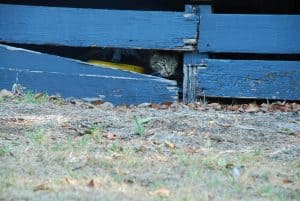Many scaredy cats will only be able to be brought back to safety through humane trapping.
What’s on this page
- Best type of trap
- Tips on trapping
- Using a drop trap
- Illustrated step-by-step guide on trapping
- Trap isolators
Best type of trap
A good, genuine cat trap is a lifetime investment. ‘Box traps’ are the easiest kind to use. They contain a pressure plate which closes the door when the cat steps on it, so you don’t need to be right next to the trap.
In Australia, the standard cat trap design has a solid back metal plate that slides up and a wire door.
Don’t use possum traps or small ‘cat’ traps!
Be aware that possum traps are being marketed, especially online, as cat traps. Some companies are also selling very small so-called ‘cat traps’. Although they may be cheaper, they are much smaller than genuine cat traps and also harder to use. We have had requests for help from people who bought a so-called cat trap online and had their lost cat eat the food without being trapped, and had their cat get out of the trap. We have also seen some with sharp metal edges inside which could very easily injure a stressed trapped cat.
Where to obtain box trap
Wiretainers has a good reputation and hand-makes the traps in Melbourne. If you’re a rescue group, purchasing six traps at a time will give you a significant discount. If you’re in Melbourne, Animal Care and Equipment Services in Moorrabbin also sells genuine cat traps.
In 2018, box traps cost about $130-150. If you intend to help cats on an ongoing basis, they are an essential item.
If you don’t wish to buy your own trap, contact an animal rescue group, shelter or local council to see if you can borrow or hire one.
If you’re in or near Melbourne, Australia,, we may be able to lend you traps – both box traps and drop traps. A refundable deposit is required. Please contact us.
We may also be able to connect you with people in other parts of Victoria who will lend you a trap.
Tips on trapping
There are several things you can do to increase your trapping success:
- line the trap with newspaper – cats don’t like walking on wire
- cover the trap with a sheet, so they feel safer
- place the trap in a secluded area or alongside a structure eg fence, house, under bushes. Just make sure it’s on stable ground and won’t wobble when they step on it
- break up the food into small pieces and place most of it behind the pressure plate, but make a trail of small pieces of food leading into the trap. You can use a trail of fish sauce to help with this
- ‘chum’ the area with smell, by wiping the bait on high objects – tree trunks, fences etc. This will carry the smell, in case your cat isn’t on the property.
Why you need the trail
Your cat will follow their nose to food. Making a trail increases their ability to find the food in the trap. This is particularly important on still nights, or if the trap is upwind.
Trail brings Anastasia back to safety
Anastasia (not a scaredy cat) had become lost from her foster home through a balcony that wasn’t cat proof. Thanks to committed volunteers, she was located at a nearby park.
With no food on tap, she had no choice but to kill her own. On the night we set about trapping her, she was engrossed in eating the remains of the dinner she’d caught and refused to move towards the drop trap.
After we threw a trail of small pieces of salmon from the trap to where she was eating, she quickly picked up the scent and gradually walked towards the trap. It wasn’t long before she was brought back to safety.
Using a drop trap
If your lost cat was recently trapped, they may be ‘trap shy’ and reluctant to go into the box trap. You may need a drop trap. If you live in Melbourne, Australia, you may be able to borrow ours. Please contact us.
Illustrated step-by-step guide
Follow our detailed step by step guide [pdf] to bring your cat back to safety.
Trap isolators
ACES also stocks ‘trap isolators’. When you insert them through the top of the trap, you can easily keep your cat securely in the trap and slide up the back plate a little to provide or remove food or water.
Vet staff like them as they enable the cat to be confined to one end of the trap to administer pre-anaesthesia drugs. This is much less stressful for the cat than being manually removed from the trap. It also reduces risk of injury to vet staff.
We recommend buying two isolators, in case your cat is small or very fiesty when at the vet. They can be offset, to reduce the gap between the prongs.
